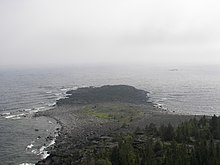Höga Kusten
The coastal area Höga Kusten (High Coast) in the Swedish province of Västernorrlands län between Härnösand and Örnsköldsvik was declared a World Heritage Site in 2000 . The region is named for the Högakustenbrücke , a suspension bridge over the Ångermanälven river .
Emergence
During the last ice age all of Scandinavia was covered in ice. The ice masses were about 3 km thick and their weight depressed the land. After the ice melted, the land began to lift. At 285 m, the Höga Kusten area has the highest isostatic elevation in the world since the last ice age. At the same time, the distance between the highest coastline and today's coastline is only about 3 km due to the topographical nature. On these 3 km the advancement of the coastline, the vegetation and also the use of the land by humans over the last 7000 years can be studied. Today the isostatic uplift has slowed down and amounts to about 8 mm per year in this area.
World natural heritage
The marine area in front of the coastline (around 56% of the area) is also part of the world natural heritage, as the geological phenomena continue into the sea. Beach fringes appear, new islands are born, islands become peninsulas. But the biological conditions in the sea are also shaped by the uplift. The Baltic Sea is a brackish sea with marine relics from the time when it was still directly connected to the Atlantic . The topography of the Höga Kusten means that there are different types of marine ecosystems within a limited area. In the summer of 2006, parts of the Kvarken region, which is mainly located in Finland, were added to the World Heritage List. The transnational World Heritage site has been called the Archipelago - Kvarken Archipelago .
The Skuleskogen National Park is located in the Höga Kusten World Natural Heritage area .
Web links
- High Coast - Visitor Guide in English
- Västernorrland Provincial Administration website on Höga Kusten
- Höga Kusten official website
Coordinates: 63 ° 0 ′ 0 ″ N , 18 ° 25 ′ 0 ″ E


